2015 Ram 1500 warning
[x] Cancel search: warningPage 300 of 347

Battery Blanket Usage
A battery loses 60% of its cranking power as the battery
temperature decreases to 0°F (-18°). For the same de-
crease in temperature, the engine requires twice as much
power to crank at the same RPM. The use of 120 Volt AC
powered battery blankets will greatly increase starting
capability at low temperatures. Suitable battery blankets
are available from your authorized MOPAR® dealer.
Cooling System
WARNING!
You or others can be badly burned by hot engine
coolant (antifreeze) or steam from your radiator. If
you see or hear steam coming from under the hood,
do not open the hood until the radiator has had time
to cool. Never try to open a cooling system pressure
cap when the radiator is hot.
Engine Coolant Checks
Check the engine coolant (antifreeze) protection every 12
months (before the onset of freezing weather, where
applicable). If the engine coolant (antifreeze) is dirty or
rusty in appearance, the system should be drained,
flushed and refilled with fresh coolant. Check the front of
the A/C condenser (if equipped) or radiator for any
accumulation of bugs, leaves, etc. If dirty, clean by gently
spraying water from a garden hose vertically down the
face of the A/C condenser (if equipped) or the back of the
radiator core.
Check the engine cooling system hoses for brittle rubber,
cracking, tears, cuts and tightness of the connection at the
coolant recovery bottle and radiator. Inspect the entire
system for leaks.
With the engine at normal operating temperature (but
not running), check the cooling system pressure cap for
proper vacuum sealing by draining a small amount of
298 MAINTAINING YOUR VEHICLE
Page 304 of 347
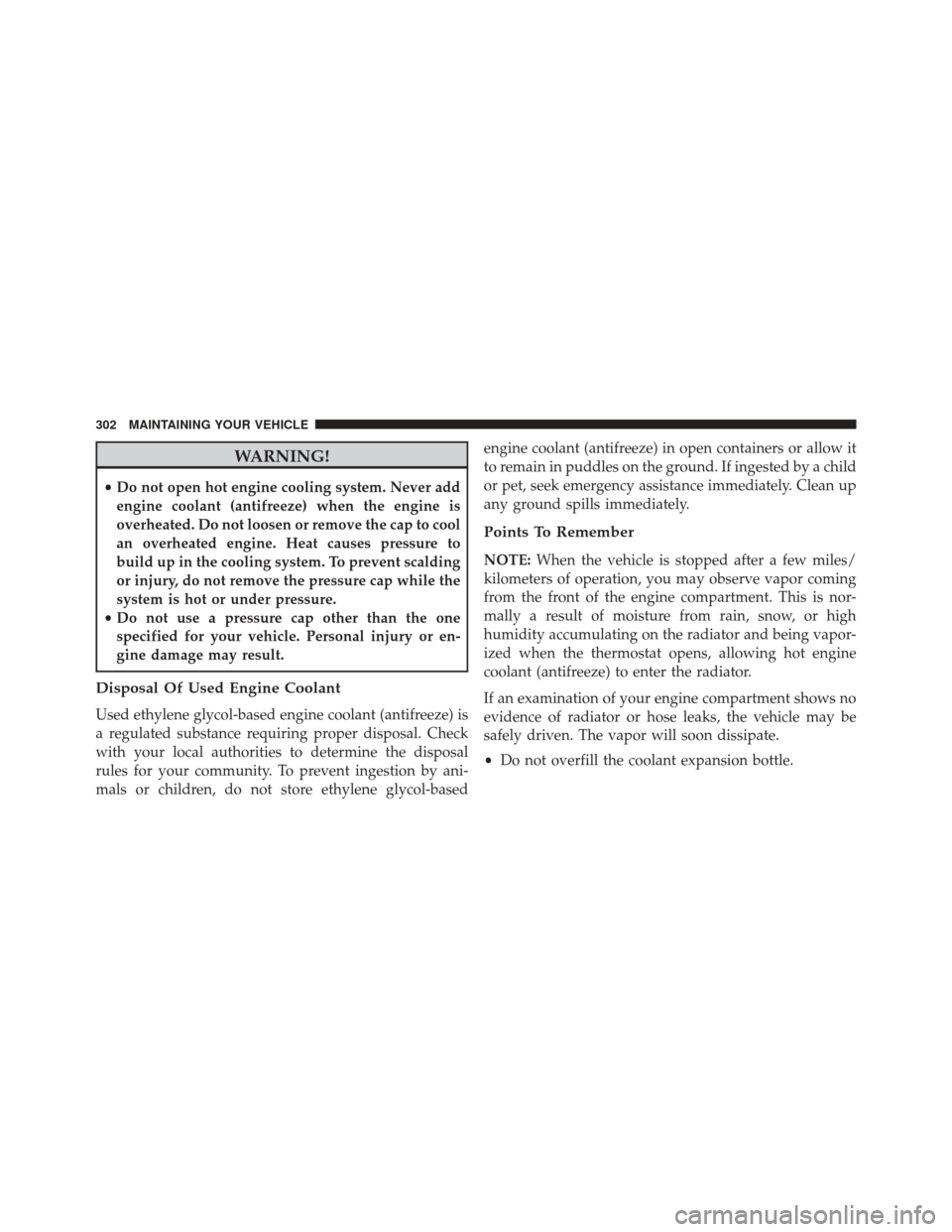
WARNING!
•Do not open hot engine cooling system. Never add
engine coolant (antifreeze) when the engine is
overheated. Do not loosen or remove the cap to cool
an overheated engine. Heat causes pressure to
build up in the cooling system. To prevent scalding
or injury, do not remove the pressure cap while the
system is hot or under pressure.
• Do not use a pressure cap other than the one
specified for your vehicle. Personal injury or en-
gine damage may result.
Disposal Of Used Engine Coolant
Used ethylene glycol-based engine coolant (antifreeze) is
a regulated substance requiring proper disposal. Check
with your local authorities to determine the disposal
rules for your community. To prevent ingestion by ani-
mals or children, do not store ethylene glycol-based engine coolant (antifreeze) in open containers or allow it
to remain in puddles on the ground. If ingested by a child
or pet, seek emergency assistance immediately. Clean up
any ground spills immediately.
Points To Remember
NOTE:
When the vehicle is stopped after a few miles/
kilometers of operation, you may observe vapor coming
from the front of the engine compartment. This is nor-
mally a result of moisture from rain, snow, or high
humidity accumulating on the radiator and being vapor-
ized when the thermostat opens, allowing hot engine
coolant (antifreeze) to enter the radiator.
If an examination of your engine compartment shows no
evidence of radiator or hose leaks, the vehicle may be
safely driven. The vapor will soon dissipate.
• Do not overfill the coolant expansion bottle.
302 MAINTAINING YOUR VEHICLE
Page 306 of 347
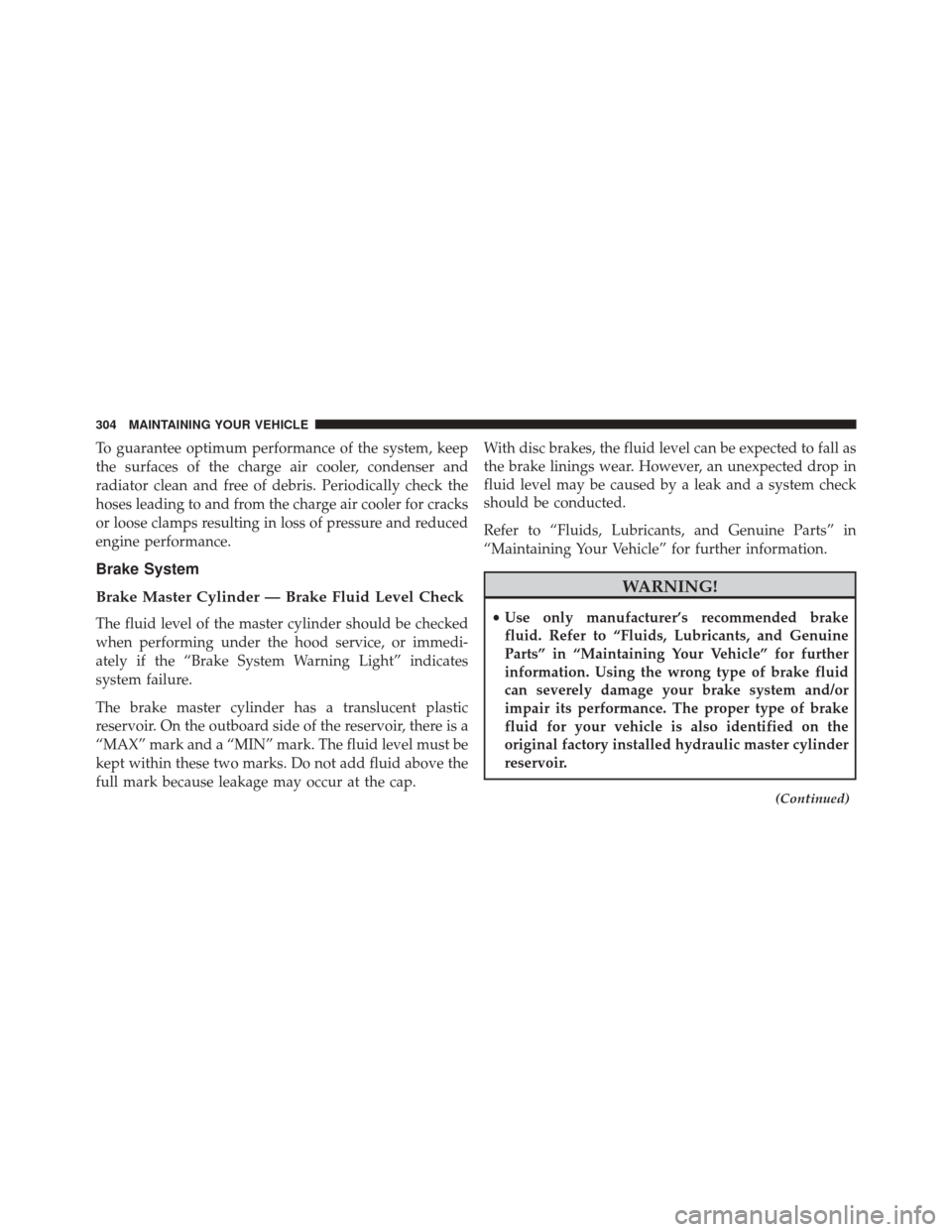
To guarantee optimum performance of the system, keep
the surfaces of the charge air cooler, condenser and
radiator clean and free of debris. Periodically check the
hoses leading to and from the charge air cooler for cracks
or loose clamps resulting in loss of pressure and reduced
engine performance.
Brake System
Brake Master Cylinder — Brake Fluid Level Check
The fluid level of the master cylinder should be checked
when performing under the hood service, or immedi-
ately if the “Brake System Warning Light” indicates
system failure.
The brake master cylinder has a translucent plastic
reservoir. On the outboard side of the reservoir, there is a
“MAX” mark and a “MIN” mark. The fluid level must be
kept within these two marks. Do not add fluid above the
full mark because leakage may occur at the cap.With disc brakes, the fluid level can be expected to fall as
the brake linings wear. However, an unexpected drop in
fluid level may be caused by a leak and a system check
should be conducted.
Refer to “Fluids, Lubricants, and Genuine Parts” in
“Maintaining Your Vehicle” for further information.
WARNING!
•
Use only manufacturer’s recommended brake
fluid. Refer to “Fluids, Lubricants, and Genuine
Parts” in “Maintaining Your Vehicle” for further
information. Using the wrong type of brake fluid
can severely damage your brake system and/or
impair its performance. The proper type of brake
fluid for your vehicle is also identified on the
original factory installed hydraulic master cylinder
reservoir.
(Continued)
304 MAINTAINING YOUR VEHICLE
Page 307 of 347
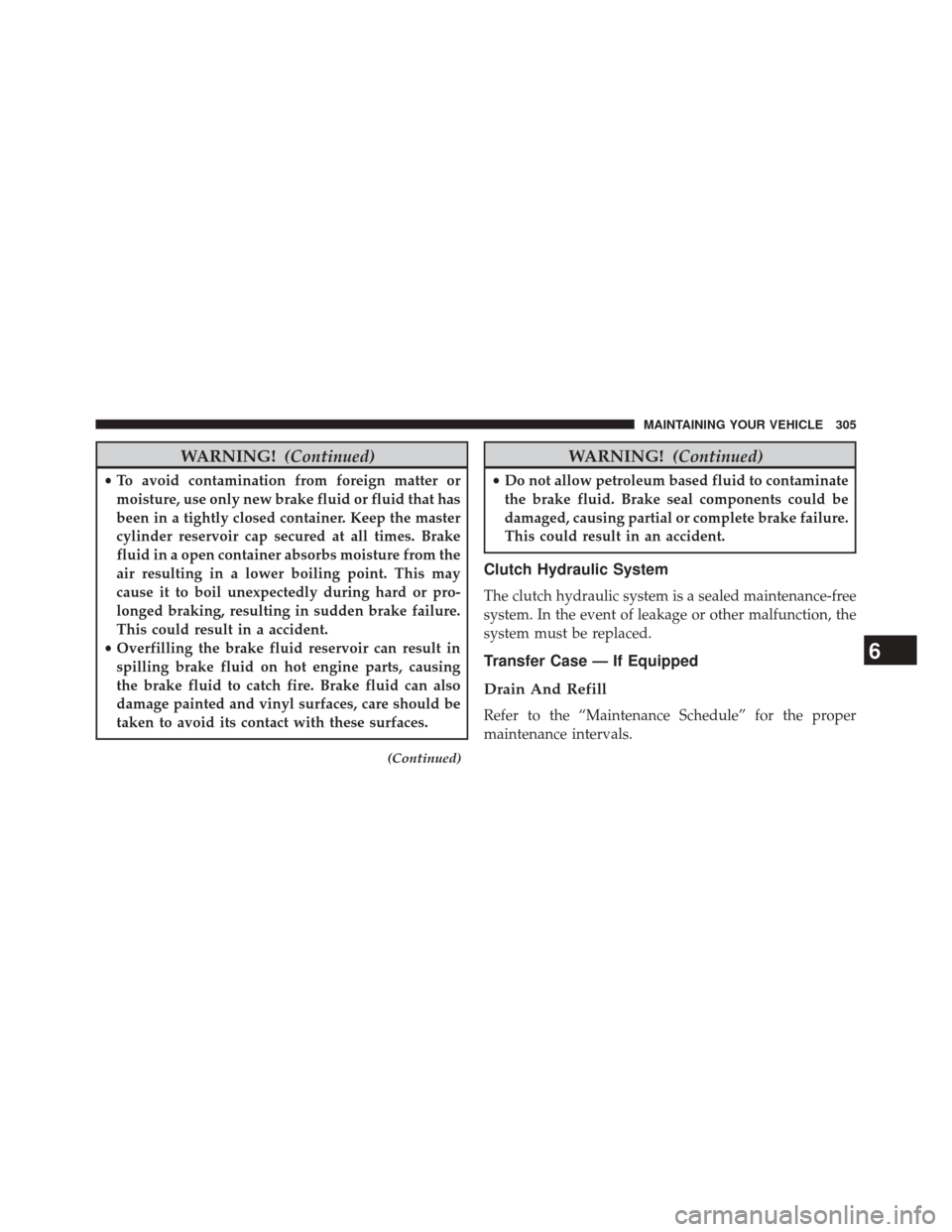
WARNING!(Continued)
•To avoid contamination from foreign matter or
moisture, use only new brake fluid or fluid that has
been in a tightly closed container. Keep the master
cylinder reservoir cap secured at all times. Brake
fluid in a open container absorbs moisture from the
air resulting in a lower boiling point. This may
cause it to boil unexpectedly during hard or pro-
longed braking, resulting in sudden brake failure.
This could result in a accident.
• Overfilling the brake fluid reservoir can result in
spilling brake fluid on hot engine parts, causing
the brake fluid to catch fire. Brake fluid can also
damage painted and vinyl surfaces, care should be
taken to avoid its contact with these surfaces.
(Continued)
WARNING! (Continued)
•Do not allow petroleum based fluid to contaminate
the brake fluid. Brake seal components could be
damaged, causing partial or complete brake failure.
This could result in an accident.
Clutch Hydraulic System
The clutch hydraulic system is a sealed maintenance-free
system. In the event of leakage or other malfunction, the
system must be replaced.
Transfer Case — If Equipped
Drain And Refill
Refer to the “Maintenance Schedule” for the proper
maintenance intervals.
6
MAINTAINING YOUR VEHICLE 305
Page 333 of 347
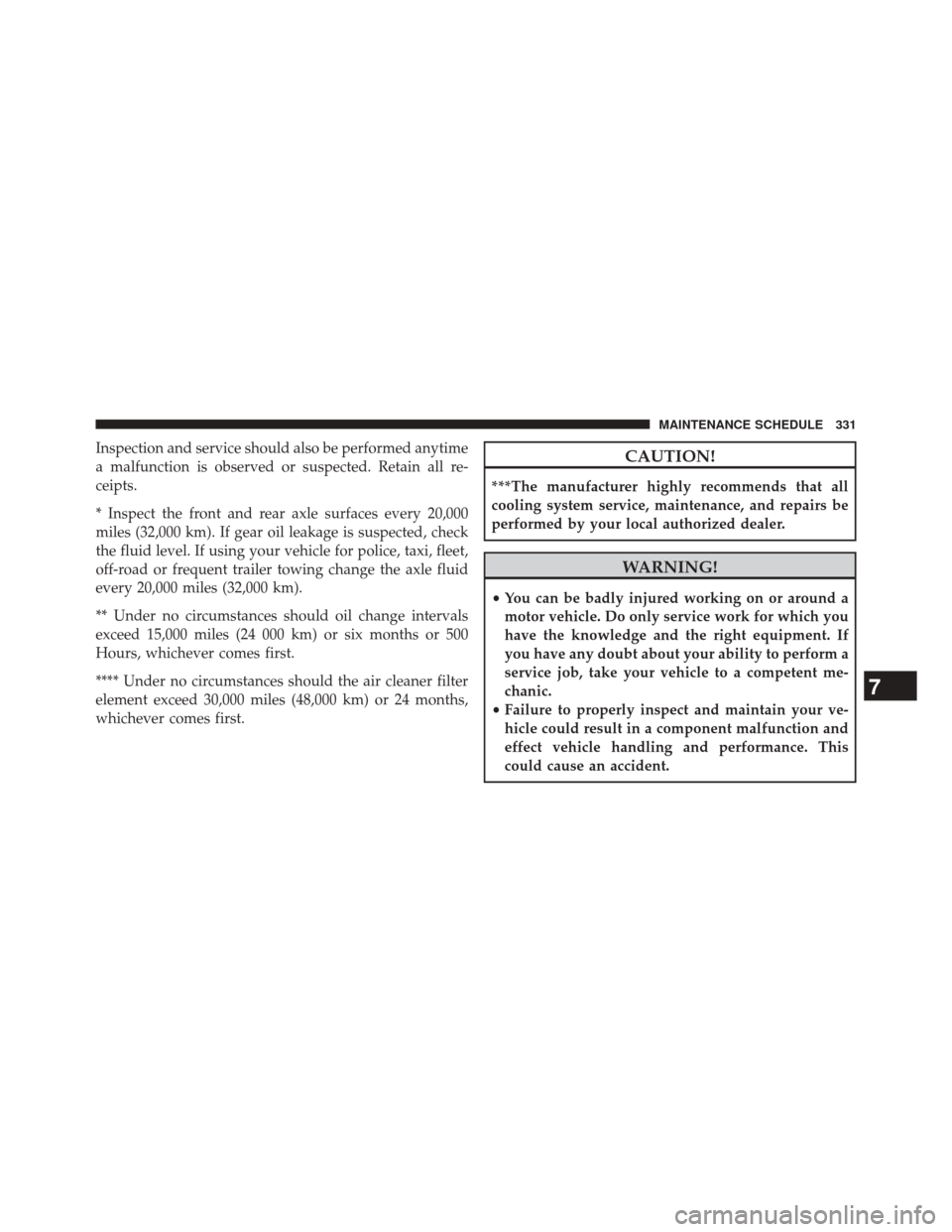
Inspection and service should also be performed anytime
a malfunction is observed or suspected. Retain all re-
ceipts.
* Inspect the front and rear axle surfaces every 20,000
miles (32,000 km). If gear oil leakage is suspected, check
the fluid level. If using your vehicle for police, taxi, fleet,
off-road or frequent trailer towing change the axle fluid
every 20,000 miles (32,000 km).
** Under no circumstances should oil change intervals
exceed 15,000 miles (24 000 km) or six months or 500
Hours, whichever comes first.
**** Under no circumstances should the air cleaner filter
element exceed 30,000 miles (48,000 km) or 24 months,
whichever comes first.CAUTION!
***The manufacturer highly recommends that all
cooling system service, maintenance, and repairs be
performed by your local authorized dealer.
WARNING!
•You can be badly injured working on or around a
motor vehicle. Do only service work for which you
have the knowledge and the right equipment. If
you have any doubt about your ability to perform a
service job, take your vehicle to a competent me-
chanic.
• Failure to properly inspect and maintain your ve-
hicle could result in a component malfunction and
effect vehicle handling and performance. This
could cause an accident.
7
MAINTENANCE SCHEDULE 331
Page 336 of 347
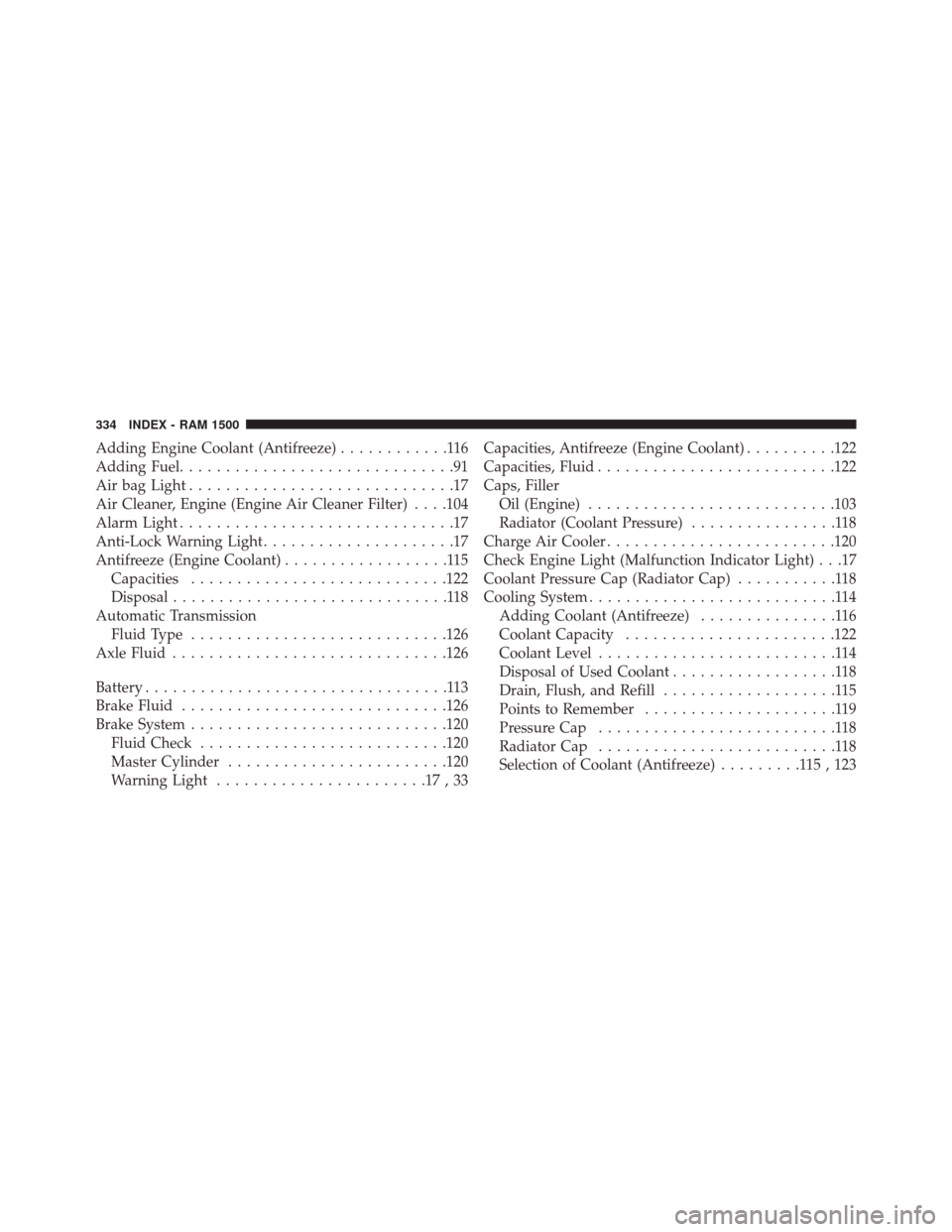
Adding Engine Coolant (Antifreeze)............116
Adding Fuel ..............................91
Air bag Light .............................17
Air Cleaner, Engine (Engine Air Cleaner Filter) . . . .104
Alarm Light ..............................17
Anti-Lock Warning Light .....................17
Antifreeze (Engine Coolant) ..................115
Capacities ........................... .122
Disposal ..............................118
Automatic Transmission Fluid Type ........................... .126
Axle Fluid ............................. .126
Battery .................................113
Brake Fluid ............................ .126
Brake System ........................... .120
Fluid Check .......................... .120
Master Cylinder ....................... .120
Warning Light .......................17,33 Capacities, Antifreeze (Engine Coolant)
..........122
Capacities, Fluid ......................... .122
Caps, Filler Oil (Engine) .......................... .103
Radiator (Coolant Pressure) ................118
Charge Air Cooler ........................ .120
Check Engine Light (Malfunction Indicator Light) . . .17
Coolant Pressure Cap (Radiator Cap) ...........118
Cooling System ...........................114
Adding Coolant (Antifreeze) ...............116
Coolant Capacity ...................... .122
Coolant Level ..........................114
Disposal of Used Coolant ..................118
Drain, Flush, and Refill ...................115
Points to Remember .....................119
Pressure Cap ..........................118
Radiator Cap ..........................118
Selection of Coolant (Antifreeze) .........115,123
334 INDEX - RAM 1500
Page 338 of 347
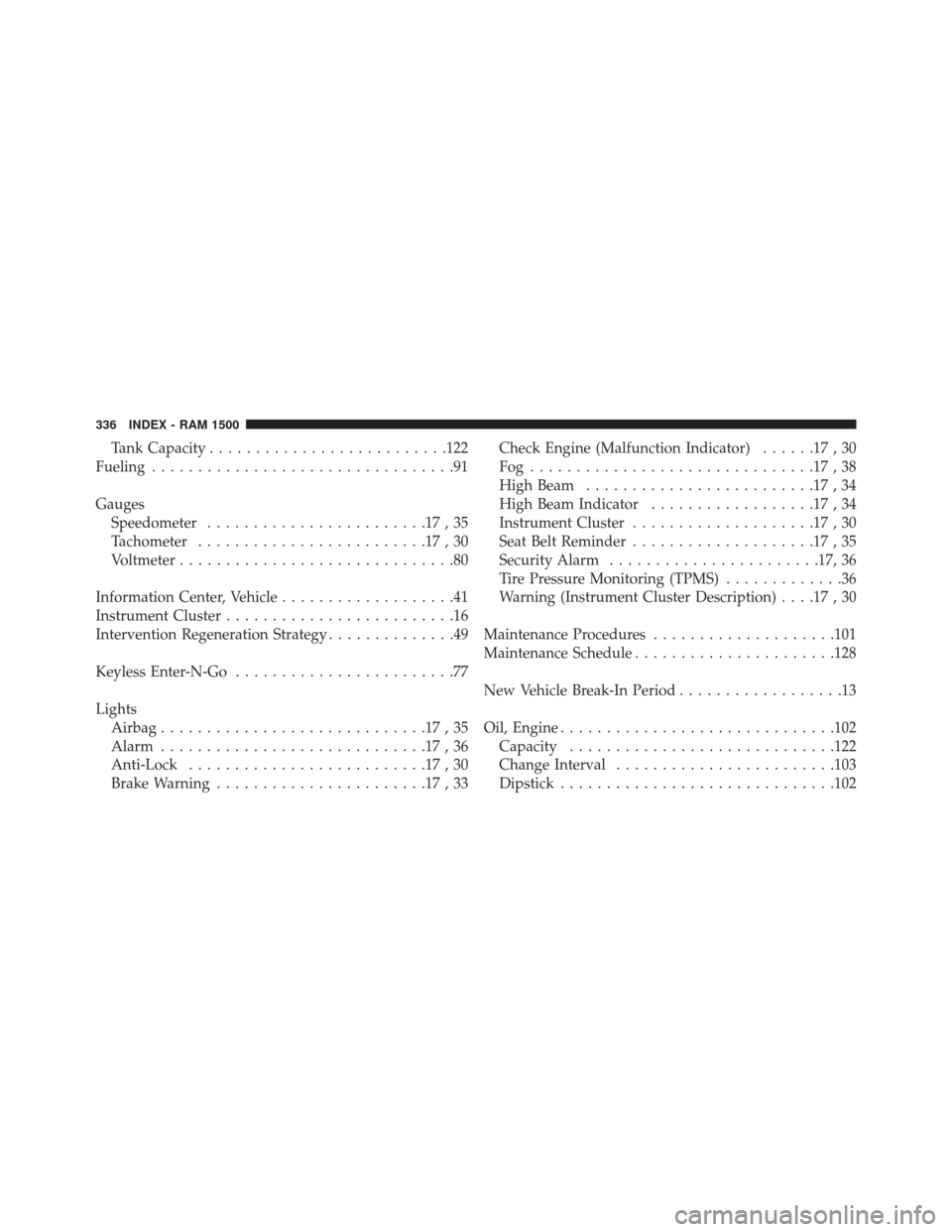
Tank Capacity......................... .122
Fueling .................................91
Gauges Speedometer ........................17,35
Tachometer .........................17,30
Voltmeter ..............................80
Information Center, Vehicle ...................41
Instrument Cluster .........................16
Intervention Regeneration Strategy ..............49
Keyless Enter-N-Go ........................77
Lights Airbag .............................17,35
Alarm .............................17,36
Anti-Lock ..........................17,30
Brake Warning .......................17,33 Check Engine (Malfunction Indicator)
......17,30
Fog ...............................17,38
High Beam .........................17,34
High Beam Indicator ..................17,34
Instrument Cluster ....................17,30
Seat Belt Reminder ....................17,35
Security Alarm ...................... .17, 36
Tire Pressure Monitoring (TPMS) .............36
Warning (Instrument Cluster Description) . . . .17 , 30
Maintenance Procedures ....................101
Maintenance Schedule ..................... .128
New Vehicle Break-In Period ..................13
Oil, Engine ............................. .102
Capacity ............................ .122
Change Interval ....................... .103
Dipstick ............................. .102
336 INDEX - RAM 1500
Page 339 of 347
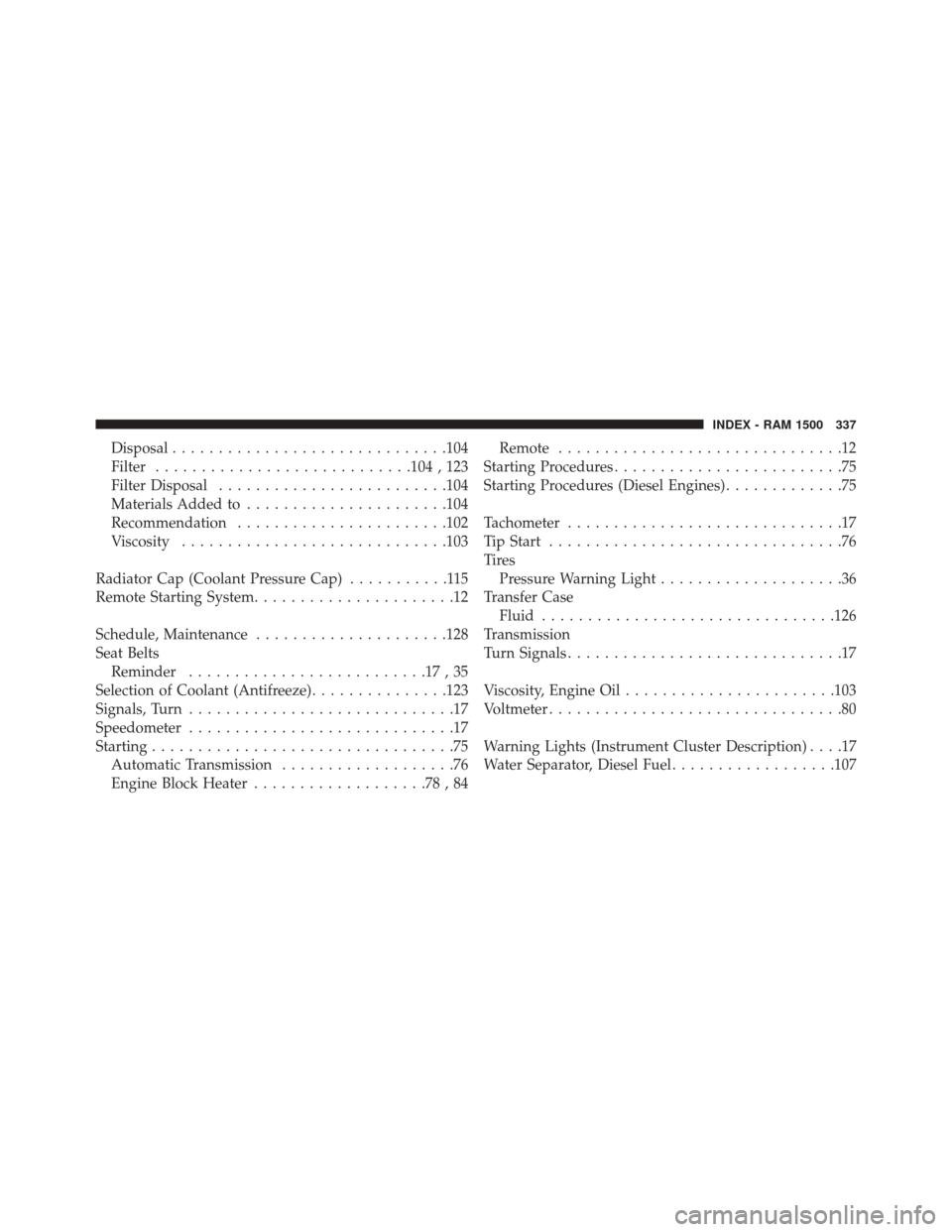
Disposal............................. .104
Filter ........................... .104 , 123
Filter Disposal ........................ .104
Materials Added to ..................... .104
Recommendation ...................... .102
Viscosity ............................ .103
Radiator Cap (Coolant Pressure Cap) ...........115
Remote Starting System ......................12
Schedule, Maintenance .....................128
Seat Belts Reminder ..........................17,35
Selection of Coolant (Antifreeze) ...............123
Signals, Turn .............................17
Speedometer .............................17
Starting .................................75
Automatic Transmission ...................76
Engine Block Heater ...................78,84 Remote
...............................12
Starting Procedures .........................75
Starting Procedures (Diesel Engines) .............75
Tachometer ..............................17
Tip Start ................................76
Ti re s Pressure Warning Light ....................36
Transfer Case Fluid ............................... .126
Transmission
Turn Signals ..............................17
Viscosity, Engine Oil ...................... .103
Voltmeter ................................80
Warning Lights (Instrument Cluster Description) ....17
Water Separator, Diesel Fuel ..................107
INDEX - RAM 1500 337